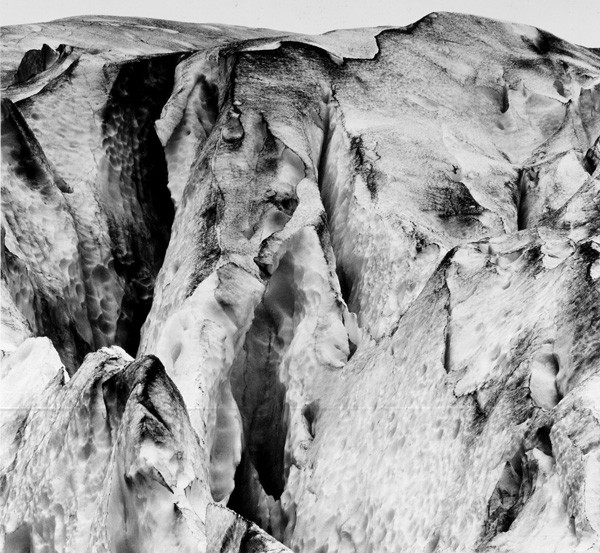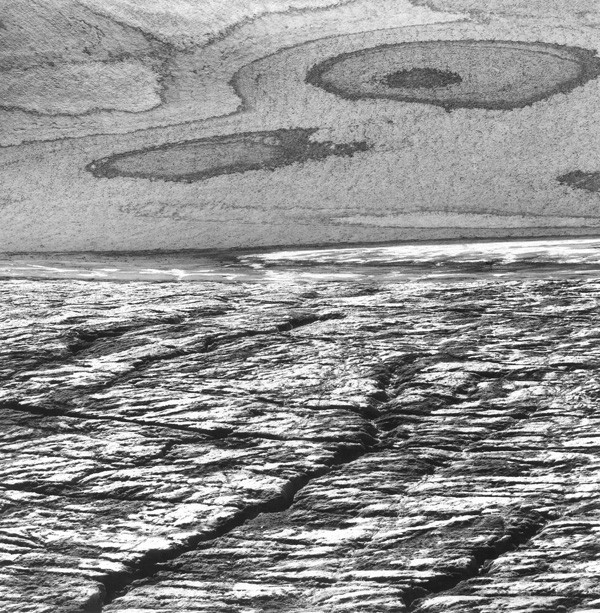Detlef Orlopp »In the light of the glacier«
28 Mar - 24 May 2014
Detlef Orlopp »In the light of the glacier«
28th March – 24th May 2014
Opening Stuttgart: Thursday, 27th March 2014, 7 - 9 pm
Introduction Dr. Dietrich Heissenbüttel
Artist’s talk: Thursday, 8th May 2014, 7.30 pm with Dr. Dietrich Heissenbüttel
He was silent for a moment. Listened to the silence of the desert – a labyrinth of silence. He lifted his head up to the mysterious moon and the imposing peaks of the Îdenan mountain, its mysterious majestic nature enhanced by the light of the moon. “That alone was enough. The beauty of the full moon and the enigmatic light of the mountain. This silence. Listen to this silence, you fool. Is all this not enough of a reason for being alive? Is this not justification enough for being happy ...?” (Ibrahim al-Koni, The Animists, 2001)
A central characteristic of Detlef Orlopp’s photographs seems to be that they are difficult to describe. Featuring mountains or lakes, his landscapes are full of details that take up the entire picture; with their horizon elevated, they lack any form of human presence. In a discrete and reserved way, the photographer registers structural occurrences between black and white, in which romantic experiences of the sublime intensify and refer to something primal and earthly.
Detlef Orlopp captures a perspective that categorically excludes a hierarchy of meaning. The result is “an almost consistently smooth structure of signs produced by the light, which gives every contour on the ground a hard shadow” (Peter Weiermair). In the aloofness that renounces any kind of intervention, there is a void and calmness associating Orlopp’s concrete photography with a transcendence completely disengaged from faith.
Alongside his landscape photography, Detlef Orlopp has also been taking portraits of people since the 1960s. In the same way that nature develops concrete topographic sites into signs of landscape, so too do his portraits reflect a distanced perspective that still seeks a sense of proximity, turning concrete individuals into signs of humanity. The exhibition of Orlopp’s portraits draws an arch to Max Bense, who had already exhibited photographs by Detlef Orlopp in the faculty gallery that he headed at the Technische Hochschule Stuttgart in 1967.
Detlef Orlopp (born in 1937 in Elbing/West Prussia) studied at the Staatliche Höhere Fachschule für Photographie in Cologne and the Staatliche Schule für Kunst und Handwerk in Saarbrücken under Otto Steinert, whom he followed to the Folkwangschule in Essen in 1959. Two years later, he received a teaching assignment at the Werkkunstschule in Krefeld, where Orlopp was appointed Professor for Photography and Film in 1973 and where he worked until his retirement. In line with the acquisition of Detlef Orlopp’s photographic work, Museum Folkwang Essen will be devoting a comprehensive retrospective to the artist in 2015.
28th March – 24th May 2014
Opening Stuttgart: Thursday, 27th March 2014, 7 - 9 pm
Introduction Dr. Dietrich Heissenbüttel
Artist’s talk: Thursday, 8th May 2014, 7.30 pm with Dr. Dietrich Heissenbüttel
He was silent for a moment. Listened to the silence of the desert – a labyrinth of silence. He lifted his head up to the mysterious moon and the imposing peaks of the Îdenan mountain, its mysterious majestic nature enhanced by the light of the moon. “That alone was enough. The beauty of the full moon and the enigmatic light of the mountain. This silence. Listen to this silence, you fool. Is all this not enough of a reason for being alive? Is this not justification enough for being happy ...?” (Ibrahim al-Koni, The Animists, 2001)
A central characteristic of Detlef Orlopp’s photographs seems to be that they are difficult to describe. Featuring mountains or lakes, his landscapes are full of details that take up the entire picture; with their horizon elevated, they lack any form of human presence. In a discrete and reserved way, the photographer registers structural occurrences between black and white, in which romantic experiences of the sublime intensify and refer to something primal and earthly.
Detlef Orlopp captures a perspective that categorically excludes a hierarchy of meaning. The result is “an almost consistently smooth structure of signs produced by the light, which gives every contour on the ground a hard shadow” (Peter Weiermair). In the aloofness that renounces any kind of intervention, there is a void and calmness associating Orlopp’s concrete photography with a transcendence completely disengaged from faith.
Alongside his landscape photography, Detlef Orlopp has also been taking portraits of people since the 1960s. In the same way that nature develops concrete topographic sites into signs of landscape, so too do his portraits reflect a distanced perspective that still seeks a sense of proximity, turning concrete individuals into signs of humanity. The exhibition of Orlopp’s portraits draws an arch to Max Bense, who had already exhibited photographs by Detlef Orlopp in the faculty gallery that he headed at the Technische Hochschule Stuttgart in 1967.
Detlef Orlopp (born in 1937 in Elbing/West Prussia) studied at the Staatliche Höhere Fachschule für Photographie in Cologne and the Staatliche Schule für Kunst und Handwerk in Saarbrücken under Otto Steinert, whom he followed to the Folkwangschule in Essen in 1959. Two years later, he received a teaching assignment at the Werkkunstschule in Krefeld, where Orlopp was appointed Professor for Photography and Film in 1973 and where he worked until his retirement. In line with the acquisition of Detlef Orlopp’s photographic work, Museum Folkwang Essen will be devoting a comprehensive retrospective to the artist in 2015.


